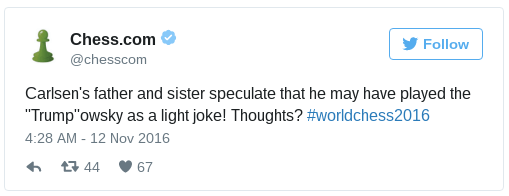
Magnus Carlsen (white) played the Trompowsky Attack in the opening game of the World Chess Championship 2016.
Although World Chess Champion Magnus Carlsen has used the Trompowsky Attack before, it came as quite a surprise as it is not the most common way to continue after the moves 1. d4 Nf6.
The Trompowsky opening has less theory attached to it compared to other Queen’s Pawn openings, which may be one reason why Magnus Carlsen chose it for the first game of the championship.
Another reason, as he partially admitted in the post-match press conference, may have been that the name sounds like “Trump-owsky” and was a cheeky way to refer to Donald Trump’s victory in the US presidential election earlier in the week. Magnus Carlsen’s family certainly thought so. When asked if that had anything to do with his choice of opening he replied, with a grin,
A little bit.
Perhaps Magnus Carlsen’s challenger, Sergey Karjakin was expecting Carlsen’s second move to be c4, advancing his Queen’s Bishop’s Pawn two spaces to land next to the Queen’s Pawn, which is a much more common continuation.
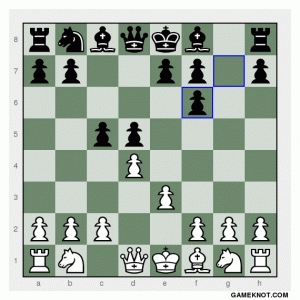
What Is The Point Of The Trompowsky Attack?
The Trompowsky Attack is less well known or studied by most club players, so it can be a good way for White to steer Black into less familiar situations on the chess board.
Black’s typical defences that follow 1. d4 Nf6 are the heavily analyzed Nimzo-Indian, King’s Indian, Grunfield and Modern Benoni.
However, by placing the Bishop on g5 in the second move – the move that defines the Trompowsky – White easily avoids all of those systems.
In placing the Bishop on g5, White is preparing to exchange his Bishop for the Knight. This usually results in a trade-off in which (1) Black gets to keep both Bishops (which could be an advantage in an open game after some pawns have been exchanged), but (2) Black has doubled pawns on the f-file (see diagram).
After that, White should aim for quick development to take advantage of the imbalances that have been created.
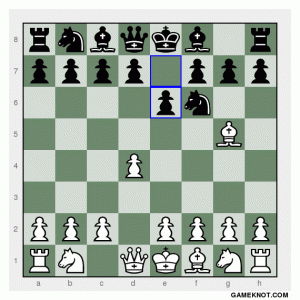
How Black Avoids Doubled Pawns
(1) Black can avoid doubled pawns by responding to 2. Bg5 with e6, moving the King’s Pawn up one space (just as if Black is playing the Nimzo-Indian).
Then, if White takes the Knight with the Bishop (B x f6), Black can reply Q x f6.
The only problem is that moving the pawn to e6 pins Blacks Knight to the Queen, so Black needs to play carefully and beware of a swift advance of White’s e pawn which could attack the pinned Knight.
Surviving The Trompowsky Attack with 2… e6
In a recent game where I was Black and faced with the Trompowsky, I avoided doubling my pawns by playing 3 … e6. I ended up with a satisfactory Queen’s Indian kind of set-up, with my Bishop dominating the a8-h1 diagonal.
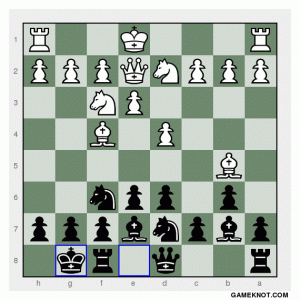
- d4 Nf6
- Bg5 e6
- e3 b6
- Nf3 Bb7 (a kind of Queen’s Indian defence, with my Knight still pinned to my Queen.)
- Nd2 d6
- Bb5+ Nbd7
- Qe2 Be7 (Finally unpinning the Queen. On reflection, this move was a little late!)
- Bf3 0-0
I think Black is better as the middle game approaches.
In the event, White castled on the Queen’s side and I launched an immediate queenside attack with a6 (attacking the Bishop). The result was eventually a win for Black.
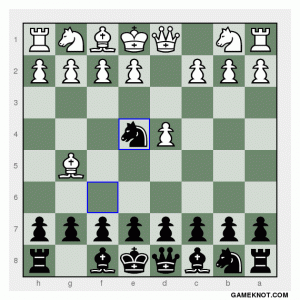
(2) Black can avoid doubled pawns by advancing the Knight to e4.
This is the most dynamic response to the Trompowsky attack and is recommended by Grandmaster Boris Avrukh in his book, Beating 1.d4 Sidelines (not recommended for anybody with a rating of less than 1800, but excellent reading for advanced players).
With 2… Ne4 Black’s Knight immediately counter-attacks White’s Bishop. These moves usually follow:
3. Bf4 d5
4. f3 N f6
How Sergey Karjakin Handled The Trompowsky Attack
In the opening game of the World Chess Championships, Sergey Karjakin did not seek to avoid doubled pawns. He played,
2… d5 and the game continued:
3. e3 c5
4. Bx f6 gxf6 (4… e x f6 is also fine here.)
The game ended in a draw. For more info about the opening game of the World Chess Championship, with a clear explanation of what Carlsen was seeking with the Trompowsky attack, I recommend the post-game video analysis of GM Huschenbeth.
David Hurley
EasyChessTips.com
